Struts2 AngularJS integration
In this post, we will learn to implement AJAX calls from a JSP page to a Struts 2 Action class using AngularJS and update the same JSP page back with the Json response from the Struts 2.
Library Required
Since Angular can send and receive only in json format, to handle it you need struts2-json-plugin-2.x.x.jar. This plugin allows you to serialize the Action class attribute which has getter and setter into a JSON object.
How to use?
First of all create a “Dynamic Web Project” in Eclipse and download the AngularJS library and place in js folder of eclipse work-space, and refer this files in the head section in the jsp, this file is responsible for the AJAX call made to the Struts2 and for updating the response back in the JSP.
Jsp Page
File: index.jsp
<!DOCTYPE html>
<html>
<head>
<meta charset="ISO-8859-1">
<title>AJAX with Struts 2 using AngularJS</title>
<script type="text/javascript" src="js/angular.min.js"></script>
<script>
var app = angular.module('myApp', []);
function MyController($scope, $http) {
$scope.getDataFromServer = function() {
$http.get("angularAction").success(
function(data, status, headers, config) {
$scope.person = data;
}).error(function(data, status, headers, config) {
// called asynchronously if an error occurs
// or server returns response with an error status.
});
};
};
</script>
</head>
<body>
<div data-ng-app="myApp">
<div data-ng-controller="MyController">
<button data-ng-click="getDataFromServer()">
Fetch data from server
</button>
<p>First Name : {{person.firstName}}</p>
<p>Last Name : {{person.lastName}}</p>
</div>
</div>
</body>
</html>
HTML – Data Binding
We can display JSON data values in jsp by using their attributes in expressions like {{person.firstName}}, {{person.lastName}} etc.. Here the id=”ng-app” is most important for Internet Explorer browser data binding.
ng-controller
Specifies a JavaScript controller class that evaluates HTML expressions.
ng-click
Angular on click event
Model class
package com.model;
public class PersonData {
private String firstName;
private String lastName;
// Create Getters and Setters
}
Recommended Reading:
- AJAX implementation in Struts 2 using JQuery and JSON
- jQuery Tutorial for Beginners
- GridView in Struts2 using jQuery DataTable via Ajax
Action Class
In action class you need to create instance variables and its respective getter and setter methods. Here all the variables that have a setter can be set to the values received as parameters from AngularJs and all the variables that have a getter method can be retrieved in the AngularJs code.
package com.action;
import com.model.PersonData;
import com.opensymphony.xwork2.Action;
public class AngularAction implements Action {
private PersonData personData = new PersonData();
public String execute() {
personData.setFirstName("Mohaideen");
personData.setLastName("Jamil");
return SUCCESS;
}
public PersonData getPersonData() {
return personData;
}
public void setPersonData(PersonData personData) {
this.personData = personData;
}
}
Code Explanation
When the user clicks on “Fetch data from server” button, button click event is fired via angularJS “ng-click” directive and the ‘http’ function executes the Ajax GET request on the Servlet.
struts.xml
Since the response needed by AngularJs is of type json, so we need to convert the PersonData objects to json strings, for this you need to configure Action class in struts.xml such that it returns a json object. This configuration is as follows:
Create a package in struts.xml file, which extend json-default and specify the result type of your action class inside this package to be json. The json-default package contains an interceptor and the result type configuration for JSON requests and responses.
<struts>
<package name="default" extends="json-default">
<action name="angularAction" class="com.action.AngularAction">
<result type="json">
<param name="root">personData</param>
<param name="excludeNullProperties">true</param>
<param name="noCache">true</param>
</result>
</action>
</package>
</struts>
Note: json-default package extends struts-default
Web.xml
<display-name>Struts2</display-name>
<filter>
<filter-name>struts2</filter-name>
<filter-class>
org.apache.struts2.dispatcher.ng.filter.StrutsPrepareAndExecuteFilter
</filter-class>
</filter>
<filter-mapping>
<filter-name>struts2</filter-name>
<url-pattern>/*</url-pattern>
</filter-mapping>
<welcome-file-list>
<welcome-file>index.jsp</welcome-file>
</welcome-file-list>
</web-app>
Recommended Article :
Demo
Once you done with above steps then Right click on project –> Run As –> Run on Server
(Note: I have used tomcat server to run this application. If you are not sure how to configure tomcat server in eclipse please follow this link).
Click button: Fetch data from server to pass HTTP request using angularJS where Java servlet will return data as below:

Reference
Read MoreAngularJS Interacting with Java Servlet using JSON
In this post, I am going to demonstrate a simple example on how to make AJAX calls from a JSP page to a Servlet using AngularJS and update the same JSP page back with the JSON response from the Servlet. In other words, this post will give you an overview on how to integrate AngularJS in a Java web applications.
There are many JSON libraries available that can be used to pass AJAX updates between the server and the client. I am going to use google’s gson library in this example.
Below are the steps to reproduce to create a simple AngularJS enabled Java Web Application using Eclipse and Tomcat 7,
How to use?
First of all create a “Dynamic Web Project” in Eclipse and download the AngularJS library and place in js folder of eclipse work-space, and refer this files in the head section in the jsp, this file is responsible for the AJAX call made to the servlet and for updating the response back in the JSP.
Jsp Page
<!DOCTYPE html>
<html>
<head>
<meta charset="ISO-8859-1">
<title>AJAX with Servlets using AngularJS</title>
<script type="text/javascript" src="js/angular.min.js"></script>
<script>
var app = angular.module('myApp', []);
function MyController($scope, $http) {
$scope.getDataFromServer = function() {
$http({
method : 'GET',
url : 'javaAngularJS'
}).success(function(data, status, headers, config) {
$scope.person = data;
}).error(function(data, status, headers, config) {
// called asynchronously if an error occurs
// or server returns response with an error status.
});
};
};
</script>
</head>
<body>
<div ng-app="myApp">
<div ng-controller="MyController">
<button ng-click="getDataFromServer()">Fetch data from server</button>
<p>First Name : {{person.firstName}}</p>
<p>Last Name : {{person.lastName}}</p>
</div>
</div>
</body>
</html>
HTML – Data Binding
We can display JSON data values in jsp by using their attributes in expressions like {{person.firstName}}, {{person.lastName}} etc.. Here the id=”ng-app” is most important for Internet Explorer browser data binding.
ng-controller
Specifies a JavaScript controller class that evaluates HTML expressions.
ng-click
Angular on click event
Model class
package com.model;
public class PersonData {
private String firstName;
private String lastName;
public String getFirstName() {
return firstName;
}
public void setFirstName(String firstName) {
this.firstName = firstName;
}
public String getLastName() {
return lastName;
}
public void setLastName(String lastName) {
this.lastName = lastName;
}
}
Recommended Reading:
- AJAX in Servlet & jsp using JQuery
- jQuery Tutorial for Beginners
- Autocomplete in java web application using Jquery and JSON
Servlet
Now let’s go on and write the servlet which handles this Ajax call
package com.controller;
import java.io.IOException;
import javax.servlet.ServletException;
import javax.servlet.http.HttpServlet;
import javax.servlet.http.HttpServletRequest;
import javax.servlet.http.HttpServletResponse;
import com.google.gson.Gson;
import com.model.PersonData;
public class AngularJsServlet extends HttpServlet {
private static final long serialVersionUID = 1L;
public AngularJsServlet() {
super();
}
protected void doGet(HttpServletRequest request,
HttpServletResponse response) throws ServletException, IOException {
PersonData personData = new PersonData();
personData.setFirstName("Mohaideen");
personData.setLastName("Jamil");
String json = new Gson().toJson(personData);
response.setContentType("application/json");
response.getWriter().write(json);
}
}
Code Explanation
When the user clicks on “Fetch data from server” button, button click event is fired via angularJS “ng-click” directive and the ‘http’ function executes the Ajax GET request on the Servlet.
Web.xml
Make sure you have done servlet mapping in web.xml as shown below
<web-app>
<welcome-file-list>
<welcome-file>index.jsp</welcome-file>
</welcome-file-list>
<servlet>
<servlet-name>javaAngularJS</servlet-name>
<servlet-class>com.controller.AngularJsServlet</servlet-class>
</servlet>
<servlet-mapping>
<servlet-name>javaAngularJS</servlet-name>
<url-pattern>/javaAngularJS</url-pattern>
</servlet-mapping>
</web-app>
Demo
Once you done with above steps then Right click on project –> Run As –> Run on Server
(Note: I have used tomcat server to run this application. If you are not sure how to configure tomcat server in eclipse please follow this link).
Click button: Fetch data from server to pass HTTP request using angularJS where Java servlet will return data as below:

Reference
Read MoreAjax Cascading DropDownList in JSP & Servlet using JQuery and JSON
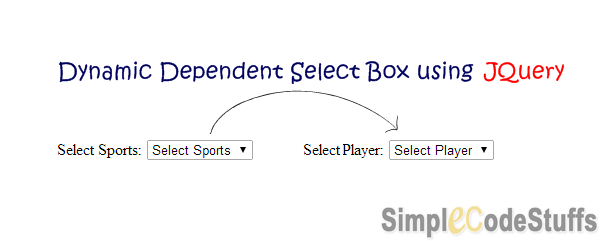
There are times in a web application where you want to populate a dropdown list based on the value of another drop down list. In this example, we will be creating a dropdown list for favorite spots and favorite player; since this scenario involves in returning complex java objects like lists, maps, etc, so I’m using JSON for this purpose.
In the article on AJAX in Servlet & jsp using JQuery I have demonstrated on returning simple object from servlet to jsp via jquery.
Library required
Project Structure
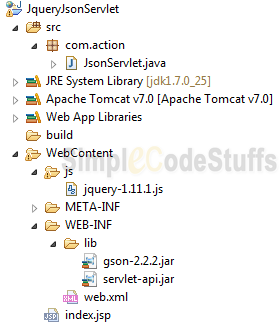
Steps done to set up our Servlet for JSON
From the browser perspective: jQuery
jQuery allows you to fire an ajax request via get or post method and expects a JSON object as a response, as described in my previous post the first and second parameter of these method are the url and a key-value pair and the third argument of get method is a function that defines what is to be done with the response that is got back from the Servlet.
Recommended reading:
Jsp Page
<html>
<head>
<title>AJAX in Servlet using JQuery and JSON</title>
<script src="js/jquery-1.11.1.js" type="text/javascript"></script>
<script>
$(document).ready(function() {
$('#sports').change(function(event) {
var sports = $("select#sports").val();
$.get('JsonServlet', {
sportsName : sports
}, function(response) {
var select = $('#player');
select.find('option').remove();
$.each(response, function(index, value) {
$('<option>').val(value).text(value).appendTo(select);
});
});
});
});
</script>
</head>
<body>
<h3>AJAX in Servlet using JQuery and JSON</h3>
Select Favorite Sports:
<select id="sports">
<option>Select Sports</option>
<option value="Football">Football</option>
<option value="Cricket">Cricket</option>
</select>
<br /> <br />
Select Favorite Player:
<select id="player">
<option>Select Player</option>
</select>
</body>
</html>
Here jquery will fire an ajax request when the value of the first dropdown is changed(id=”sports”).
Another must read:
- AJAX Tooltip in Java Web Application using qTip2 jQuery plugin
- jQuery form validation using jQuery Validation plugin
- Pagination in Servlet and JSP using jQuery jTable plugin
From the server’s perspective: Servlet
In Servlet, I’m going to use a GSON library to convert Java objects (lists, maps etc) to JSON strings that will be parsed by JQuery in the JSP page and will be displayed on the web page and note that I have returned the response back to jsp based on the value of sports parameter which i pass to the servlet via jQuery’s get() method.
Servlet
package com.action;
import java.io.IOException;
import java.util.*;
import javax.servlet.ServletException;
import javax.servlet.http.HttpServlet;
import javax.servlet.http.HttpServletRequest;
import javax.servlet.http.HttpServletResponse;
import com.google.gson.Gson;
public class JsonServlet extends HttpServlet {
private static final long serialVersionUID = 1L;
protected void doGet(HttpServletRequest request,
HttpServletResponse response) throws ServletException, IOException {
String sportsName = request.getParameter("sportsName");
List<String> list = new ArrayList<String>();
String json = null;
if (sportsName.equals("Football")) {
list.add("Lionel Messi");
list.add("Cristiano Ronaldo");
list.add("David Beckham");
list.add("Diego Maradona");
} else if (sportsName.equals("Cricket")) {
list.add("Sourav Ganguly");
list.add("Sachin Tendulkar");
list.add("Lance Klusener");
list.add("Michael Bevan");
} else if (sportsName.equals("Select Sports")) {
list.add("Select Player");
}
json = new Gson().toJson(list);
response.setContentType("application/json");
response.getWriter().write(json);
}
}
Web.xml
Servlet mapping should be done in web.xml as shown below
<welcome-file-list> <welcome-file>index.jsp</welcome-file> </welcome-file-list> <servlet> <servlet-name>JsonServlet</servlet-name> <servlet-class>com.action.JsonServlet</servlet-class> </servlet> <servlet-mapping> <servlet-name>JsonServlet</servlet-name> <url-pattern>/JsonServlet/*</url-pattern> </servlet-mapping>
Demo
On selecting ‘Football’ in the first dropdown list
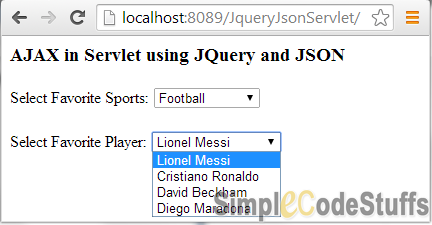
On selecting ‘Cricket’ in the first dropdown list
Other Ajax tutorial from our Blog
- AJAX implementation in Servlets using JQuery and JSON
- AngularJS Interacting with Java Servlet using JSON
- Refresh DIV Content Without Reloading Page using jQuery
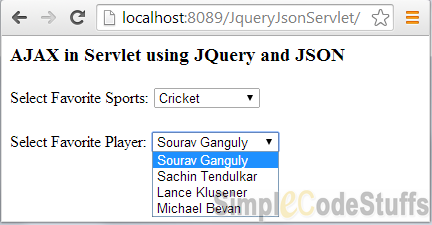
Reference
Read More
AJAX Tooltip in Java Web Application using qTip2 jQuery plugin
This article discusses AJAX Tooltip in Java Web Application using qTip2 jQuery plugin. This library is used for creating Asynchronous display of tool tip.
Library required
Project Structure
Now Create a dynamic web project in Eclipse with following folder structure
Set up from browser perspective: jQuery qTip2
Jsp form which ToolTip via ajax
<!DOCTYPE html>
<html>
<head>
<link rel="stylesheet" href="./css/jquery.qtip.min.css" type="text/css" media="screen"/>
<title>AJAX Tool tip using qTip2 jQuery plugin</title>
<style>
.qtip-content {
border: 1px solid grey;
}
.student-name {
color: blue;
cursor: pointer;
}
.name-style {
font-weight: bold;
font-size: 14px
}
.style {
font-weight: bold;
}
</style>
</head>
<body>
<h2>Qtip2 Demo With Ajax Call</h2>
<h3>Student Details</h3>
<p >
<span class="student-name" id="1" >Mohaideen</span> <br>
<span class="student-name" id="2">Ameer</span> <br>
<span class="student-name" id="3">Badru</span> <br>
<span class="student-name" id="4">Prabhu</span>
</p>
<script src="./js/jquery-1.9.0.min.js"></script>
<script src="./js/jquery.qtip.min.js"></script>
<script>
$(document).ready(function(){
$('span.student-name').each(function()
{
$(this).qtip(
{
content: {
text: '<img src="./image/loading.gif" alt="Loading..." />',
ajax: {
url: './Qtip2Servlet',
type: 'GET',
data: {id :$(this).attr('id')},
dataType: 'json',
success: function(data, status) {
var content = new Array();
content.push("<div class='name-style'>"+data.name+"</div><br>");
content.push("<div class='style'>Mark : "+data.mark+"</div>");
content.push("<div class='style'>Roll : "+data.id+"</div>");
content.push("<div class='style'>Address : "+data.address+"</div>");
content.push("<div class='style'>Phone : "+data.phoneNo+"</div>");
this.set('content.text', content.join(""));
}
}
},
position: {
at: 'bottom center',
my: 'top center',
viewport: $(window),
effect: true
},
show: {
event: 'mouseover',
solo: true
},
hide: 'unfocus',
style: {
classes: 'qtip-light'
}
})
})
});
</script>
</body>
</html>
The JQuery code written on the head section of the jsp page is responsible for the AJAX call made to the servlet.
Another must read:
jQuery form validation using jQuery Validation plugin
jQuery Tutorial for Beginners
From the server’s perspective: Servlet
In Servlet, I’m going to use a GSON library to convert Java objects to JSON strings that will be parsed by JQuery in the JSP page and will be displayed on the web page and note that I have returned the response back to jsp based on the value of ‘id’ parameter which i pass to the servlet via jQuery’s ajax() method.
Servlet implementation
package servlet;
import java.io.IOException;
import javax.servlet.ServletException;
import javax.servlet.http.HttpServlet;
import javax.servlet.http.HttpServletRequest;
import javax.servlet.http.HttpServletResponse;
import model.Student;
import service.StudentService;
import com.google.gson.Gson;
public class Qtip2StudentServlet extends HttpServlet {
private static final long serialVersionUID = 1L;
protected void doGet(HttpServletRequest request,
HttpServletResponse response) throws ServletException, IOException {
String id = request.getParameter("id");
Student student = StudentService.getStudentWithId(id);
String json = new Gson().toJson(student);
response.setContentType("application/json");
response.getWriter().write(json);
}
}
Model class
package model;
public class Student {
private String name;
private String mark;
private String id;
private String address;
private String phoneNo;
public String getName() {
return name;
}
public String getMark() {
return mark;
}
public String getId() {
return id;
}
public String getAddress() {
return address;
}
public String getPhoneNo() {
return phoneNo;
}
public void setName(String name) {
this.name = name;
}
public void setMark(String mark) {
this.mark = mark;
}
public void setId(String id) {
this.id = id;
}
public void setAddress(String address) {
this.address = address;
}
public void setPhoneNo(String phoneNo) {
this.phoneNo = phoneNo;
}
}
Business class
This Business Service class which provides static data using model class.
package service;
import java.util.ArrayList;
import java.util.List;
import model.Student;
public class StudentService {
public static List<Student> getStudentList() {
List<Student> listOfStudent = new ArrayList<Student>();
Student s1 = new Student();
s1.setName("Mohaideen");
s1.setMark("98");
s1.setAddress("Chennai India");
s1.setPhoneNo("+91- 123456789");
s1.setId("1");
listOfStudent.add(s1);
Student s2 = new Student();
s2.setName("Ameer");
s2.setMark("90");
s2.setAddress("Kolkatta India");
s2.setPhoneNo("+91- 542789");
s2.setId("2");
listOfStudent.add(s2);
Student s3 = new Student();
s3.setName("Badru");
s3.setMark("97");
s3.setAddress("Bangalore India");
s3.setPhoneNo("+91- 123456");
s3.setId("3");
listOfStudent.add(s3);
Student s4 = new Student();
s4.setName("Prabhu");
s4.setMark("88");
s4.setAddress("Vizag India");
s4.setPhoneNo("+91- 6789012");
s4.setId("4");
listOfStudent.add(s4);
return listOfStudent;
}
public static Student getStudentWithId(String id) {
List<Student> listOfStudent = getStudentList();
Student targetStudent = null;
for (Student student : listOfStudent) {
if (student.getId().equalsIgnoreCase(id)) {
targetStudent = student;
break;
} else {
continue;
}
}
return targetStudent;
}
}
web.xml
Make sure you have done servlet mapping properly in web.xml file. An example of this is given below,
<servlet> <servlet-name>Qtip2Servlet</servlet-name> <servlet-class>servlet.Qtip2StudentServlet</servlet-class> </servlet> <servlet-mapping> <servlet-name>Qtip2Servlet</servlet-name> <url-pattern>/Qtip2Servlet</url-pattern> </servlet-mapping> <welcome-file-list> <welcome-file>index.jsp</welcome-file> </welcome-file-list>
Demo
While loading tooltip from server side, a simple loading image gets displayed as below.
Once the data is loaded from server side via ajax, that data is displayed in the browser as shown below.

Ajax implementation in Servlet without jQuery plugin

AJAX is a technique for creating better, faster, and more interactive web applications. With AJAX, your JavaScript can communicate directly with the server, using the JavaScript XMLHttpRequest object. With this object, your JavaScript can transfer data with a web server, without reloading the page.
This post elaborates on how to implement Ajax in Servlet application.
** UPDATE: Servlet Complete tutorial now available here.
Folder Structure

Jsp Page
<html> <head> <title>Ajax implementation in Servlet without Using jQuery</title> <script type="text/javascript" src="js/ajax.js"></script> </head> <body> <h3>Ajax implementation in Servlet without jQuery</h3> <br /> <div id="ajaxResponse" style="color: red; font-weight: bold"></div> <br /> Please Enter your Name : <input type="text" id="userName" onblur="doAjaxCall();" /> <br /> </body> </html>
JS File
File: ajax.js
In this file we will fire ajax to call java servlet.
//Get XMLHTTP Object
function getXMLHTTPObject() {
var xmlhttpObject = null;
try {
// For Old Microsoft Browsers
xmlhttpObject = new ActiveXObject("Msxml2.XMLHTTP");
} catch (e) {
try {
// For Microsoft IE 6.0+
xmlhttpObject = new ActiveXObject("Microsoft.XMLHTTP");
} catch (e1) {
// No Browser accepts the XMLHTTP Object then false
xmlhttpObject = false;
}
}
if (!xmlhttpObject && typeof XMLHttpRequest != 'undefined') {
// For Mozilla, Opera Browsers
xmlhttpObject = new XMLHttpRequest();
}
// Mandatory Statement returning the ajax object created
return xmlhttpObject;
}
// Change the value of the outputText field
function setAjaxOutput() {
document.getElementById('ajaxResponse').innerHTML = xmlhttpObject.responseText;
}
function handleServerResponse() {
if (xmlhttpObject.readyState == 4) {
if (xmlhttpObject.status == 200) {
setAjaxOutput();
} else {
alert("Error during AJAX call. Please try again");
}
}
}
// Implement business logic
function doAjaxCall() {
xmlhttpObject = getXMLHTTPObject();
if (xmlhttpObject != null) {
var URL = "AjaxAction?userName="
+ document.getElementById('userName').value;
xmlhttpObject.open("POST", URL, true);
xmlhttpObject.send(null);
xmlhttpObject.onreadystatechange = handleServerResponse;
}
}
Recommended reading:
Servlet
Now let’s go on and write the servlet which handles this Ajax call
package com.servlet;
import java.io.IOException;
import javax.servlet.ServletException;
import javax.servlet.http.HttpServlet;
import javax.servlet.http.HttpServletRequest;
import javax.servlet.http.HttpServletResponse;
public class AjaxServlet extends HttpServlet {
private static final long serialVersionUID = 1L;
protected void doPost(HttpServletRequest request,
HttpServletResponse response) throws ServletException, IOException {
String userName = request.getParameter("userName");
if (userName.equals("")) {
userName = "User name cannot be empty";
} else {
userName = "Hello " + userName;
}
response.setContentType("text/plain");
response.getWriter().write(userName);
}
}
I hope the code above is self explanatory.
Also read:
Web.xml
Make sure you have done servlet mapping in web.xml as shown below
<web-app>
<display-name>JqueryAjaxServlet</display-name>
<welcome-file-list>
<welcome-file>index.jsp</welcome-file>
</welcome-file-list>
<servlet>
<servlet-name>AjaxAction</servlet-name>
<servlet-class>com.servlet.AjaxServlet</servlet-class>
</servlet>
<servlet-mapping>
<servlet-name>AjaxAction</servlet-name>
<url-pattern>/AjaxAction/*</url-pattern>
</servlet-mapping>
</web-app>
Demo

On running the application the above webpage is generated, in which enter a value in the textbox and click anywhere outside the textbox, then you will see a welcome message saying “Hello (userName)”.

jQuery Tutorial for Beginners
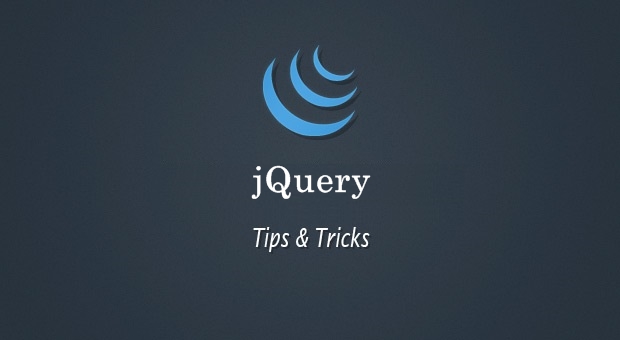
In this article we are going to take a look at introduction to jQuery, what it is, what is does and why we should use in our website.
If you are looking to perform Ajax operations in your website with lot of cool effects on it and you are not completely familiar with java script, then jQuery is a very easy and flexible way to integrate thing like effects, Ajax, animation and so on.
A Little Bit About jQuery
jQuery is Open-Source JavaScript library that contains variety of functions and other functionality that allows you to do the effects in an easier way and it is widely used for the below advantages.
- DOM manipulation
- AJAX
- Animations
- Extensibility through plugins
Why should you use it?
- Easy to learn! It uses CSS syntax for selection
- Its tiny 93.5 KB, it loads really fast in most browsers.
- Documented jquery.com & Supported forum.jquery.com
- Cross browser compatibility: IE 6+, FF 2+ and with most major browsers
- It is the most used JavaScript library on the web today
- 39% of all sites that use JavaScript use jQuery.
How to use jQuery
In order to use jQuery you need to load it, you can either include it locally on your own server:
- <script src=”/js/jquery.js”>
Or use one of the CDN’s made available:
Introduction to DOM?
The DOM is everything you write in your html documents, images, css, all your tags, everything. When a web page is loaded, the browser creates a Document Object Model of the page. The HTML DOM model is constructed as a tree of Objects.
Example: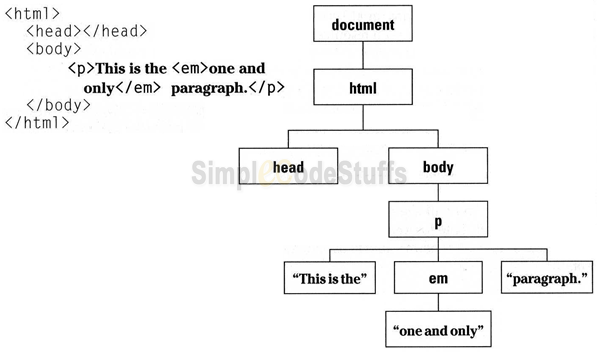
The DOM is a mess. There are a million different ways to accomplish things within it and many different doctypes and uppercase and lowercase are allowed attributes that sometimes need quotes, and other times don’t. JQuery is coded around all those inconsistencies.
JQuery can modify the DOM, but it can’t do so until the DOM is ready. So how can I be sure my code runs at DOM ready?
Wrap all your jQuery code with the document ready function.
$(document).ready(function(){
// all jQuery code goes here
});
Load Scripts at the Bottom
Problem:
When scripts are downloading they block everything else in almost all browsers!
Solution:
Best practice: The DOM is loaded top to bottom, so include your scripts at the bottom of your page so they don’t interrupt page content downloads.
And BOOM! Goes The Dynamite!!!
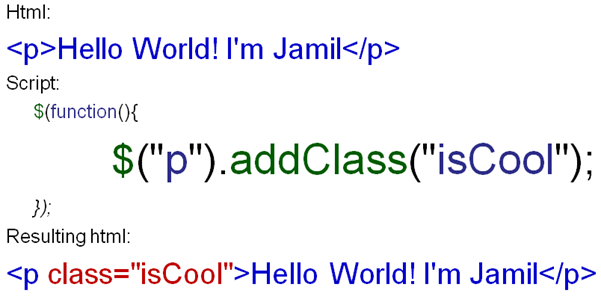
Break It Down!
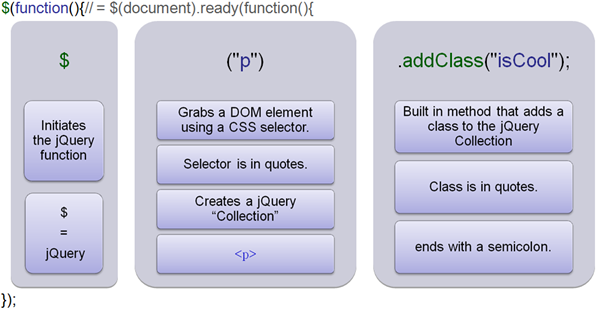
Basic jQuery Selectors
$("div"); // selects all HTML div elements
$("#myElement"); // selects one HTML element with ID "myElement"
$(".myClass"); // selects HTML elements with class "myClass"
$("p#myElement"); // selects paragraph elements with ID "myElement"
$("ul li a.navigation"); // selects anchors with class "navigation" that are nested in list items
$("p > a"); // selects anchors that are direct children of paragraphs
$("input[type=text]"); // selects inputs that have specified type
$("a:first"); // selects the first anchor on the page
$("p:odd"); // selects all odd numbered paragraphs
$("li:first-child"); // every list item that's first child in a list
Manipulating and Accessing CSS Class Names
JQuery allows you to easily add, remove, and toggle CSS classes, which comes in handy for a variety of practical uses. Here are the different syntaxes for accomplishing this:
$("div").addClass("content"); // adds class "content" to all <div> elements
$("div").removeClass("content"); // removes class "content" from all <div> elements
$("div").toggleClass("content"); // toggles the class "content" on all <div> elements
//(adds it if it doesn't exist, and removes it if it does)
You can also check to see if a selected element has a particular CSS class, and then run some code if it does. You would check this using an if statement. Here is an example:
if ($("#myElement").hasClass("content")) {
// do something here
}
You could also check a set of elements (instead of just one), and the result would return “true” if any one of the elements contained the class.
Manipulating CSS Styles with jQuery
CSS styles can be added to elements easily using jQuery, and it’s done in a cross-browser fashion. Here are some examples to demonstrate this:
$("p").css("width", "400px"); // adds a width to all paragraphs
$("#myElement").css("color", "blue") // makes text color blue on element #myElement
$("ul").css("border", "solid 1px #ccc") // adds a border to all lists
Hide and Seek
$("div").show();
Before:
<div style="display:none;">
After:
<div style="display:block;">
Similar to .show() there is a hide method as well.
$("div").hide();
Before:
<div style="display:block;">
After:
<div style="display:none;">
You Can Chain Most Methods Together
$("p").addClass("sophisticated").show();
Getters and Setters
Dual Purpose Methods

jQuery Getter
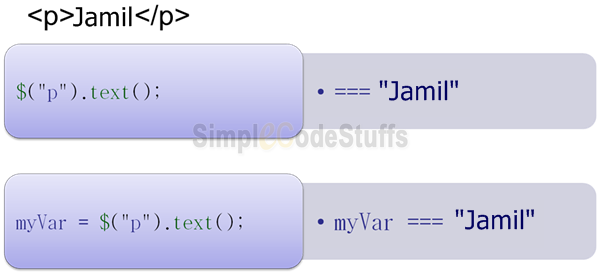
jQuery Setters

Dealing with Events in jQuery
Specific event handlers can be established using the following code:
$("#myID").click(function() {
// do something here
// when element with id="myID" is clicked is clicked
});
The code inside function() will only run when an anchor is clicked. Some other common events you might use in jQuery include: blur, focus, hover, keydown, load, mousemove, resize, scroll, submit, select.
I have explained about Ajax implementation in a click event via java web application using jQuery in the article here. In that example I have returned a simple java object from server side to and update in the jsp page via Ajax, Now inorder to return a complex java object from server side I have used JSON for this purpose. Please refer the article here to learn on how to implement Ajax in java web application using jQuery to return complex objects.

Jquery UI
jQuery UI is a curated set of user interface interactions, effects, widgets, and themes built on top of the jQuery JavaScript Library. Whether you’re building highly interactive web applications or you just need to add a date picker to a form control, jQuery UI is the perfect choice.
Refer jQueryUI.com to learn more on jQueryUi.
Jquery Plugins
“If you want to create an animation, effect or UI component, chances are pretty good that someone has done your work for you already.”
Refer plugins.jquery.com to know more about wide variety of jQuery plugins.
Listed are the few of jQuery plugins which I have explored and found to be greatly useful.
- jTable plugin
- jQuery.AjaxFileUpload plugin
- jQuery.form.js
- jQuery DataTables plugin
- jQGrid
- YUI3 jquery chart plugin
- jQuery Validation plugin
- qTip2 – The jQuery tooltip plugin
Keep in mind that this tutorial is just a bunch of straightforward code examples and brief explanations for beginners who want to avoid all the jargon and complexities. But I still highly recommend that all beginners get past this stuff by means of a good book, or by using the jQuery documentation. Thanks for reading.
